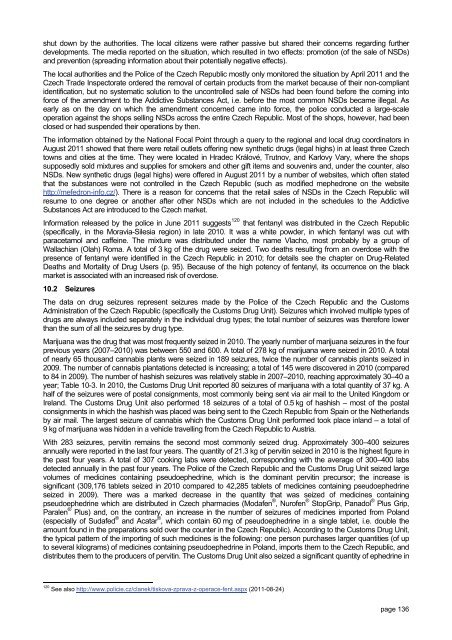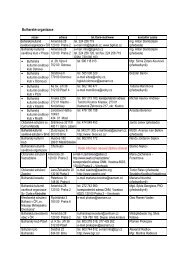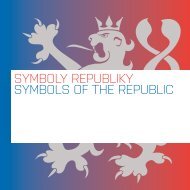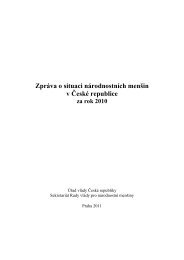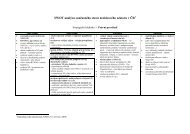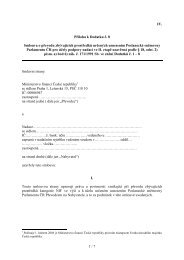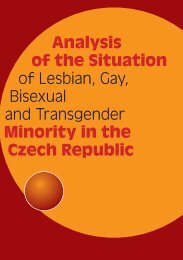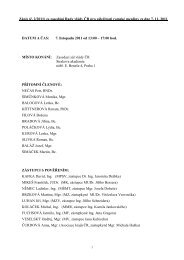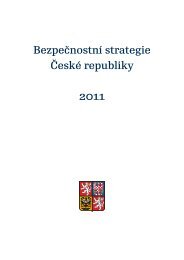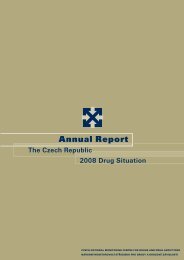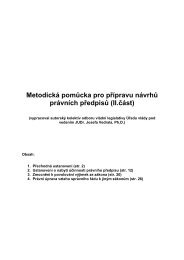The Czech Republic Annual Report 2010 Drug ... - Drogy-info.cz
The Czech Republic Annual Report 2010 Drug ... - Drogy-info.cz
The Czech Republic Annual Report 2010 Drug ... - Drogy-info.cz
You also want an ePaper? Increase the reach of your titles
YUMPU automatically turns print PDFs into web optimized ePapers that Google loves.
shut down by the authorities. <strong>The</strong> local citizens were rather passive but shared their concerns regarding further<br />
developments. <strong>The</strong> media reported on the situation, which resulted in two effects: promotion (of the sale of NSDs)<br />
and prevention (spreading <strong>info</strong>rmation about their potentially negative effects).<br />
<strong>The</strong> local authorities and the Police of the <strong>Czech</strong> <strong>Republic</strong> mostly only monitored the situation by April 2011 and the<br />
<strong>Czech</strong> Trade Inspectorate ordered the removal of certain products from the market because of their non-compliant<br />
identification, but no systematic solution to the uncontrolled sale of NSDs had been found before the coming into<br />
force of the amendment to the Addictive Substances Act, i.e. before the most common NSDs became illegal. As<br />
early as on the day on which the amendment concerned came into force, the police conducted a large-scale<br />
operation against the shops selling NSDs across the entire <strong>Czech</strong> <strong>Republic</strong>. Most of the shops, however, had been<br />
closed or had suspended their operations by then.<br />
<strong>The</strong> <strong>info</strong>rmation obtained by the National Focal Point through a query to the regional and local drug coordinators in<br />
August 2011 showed that there were retail outlets offering new synthetic drugs (legal highs) in at least three <strong>Czech</strong><br />
towns and cities at the time. <strong>The</strong>y were located in Hradec Králové, Trutnov, and Karlovy Vary, where the shops<br />
supposedly sold mixtures and supplies for smokers and other gift items and souvenirs and, under the counter, also<br />
NSDs. New synthetic drugs (legal highs) were offered in August 2011 by a number of websites, which often stated<br />
that the substances were not controlled in the <strong>Czech</strong> <strong>Republic</strong> (such as modified mephedrone on the website<br />
http://mefedron-<strong>info</strong>.<strong>cz</strong>/). <strong>The</strong>re is a reason for concerns that the retail sales of NSDs in the <strong>Czech</strong> <strong>Republic</strong> will<br />
resume to one degree or another after other NSDs which are not included in the schedules to the Addictive<br />
Substances Act are introduced to the <strong>Czech</strong> market.<br />
Information released by the police in June 2011 suggests 120 that fentanyl was distributed in the <strong>Czech</strong> <strong>Republic</strong><br />
(specifically, in the Moravia-Silesia region) in late <strong>2010</strong>. It was a white powder, in which fentanyl was cut with<br />
paracetamol and caffeine. <strong>The</strong> mixture was distributed under the name Vlacho, most probably by a group of<br />
Wallachian (Olah) Roma. A total of 3 kg of the drug were seized. Two deaths resulting from an overdose with the<br />
presence of fentanyl were identified in the <strong>Czech</strong> <strong>Republic</strong> in <strong>2010</strong>; for details see the chapter on <strong>Drug</strong>-Related<br />
Deaths and Mortality of <strong>Drug</strong> Users (p. 95). Because of the high potency of fentanyl, its occurrence on the black<br />
market is associated with an increased risk of overdose.<br />
10.2 Seizures<br />
<strong>The</strong> data on drug seizures represent seizures made by the Police of the <strong>Czech</strong> <strong>Republic</strong> and the Customs<br />
Administration of the <strong>Czech</strong> <strong>Republic</strong> (specifically the Customs <strong>Drug</strong> Unit). Seizures which involved multiple types of<br />
drugs are always included separately in the individual drug types; the total number of seizures was therefore lower<br />
than the sum of all the seizures by drug type.<br />
Marijuana was the drug that was most frequently seized in <strong>2010</strong>. <strong>The</strong> yearly number of marijuana seizures in the four<br />
previous years (2007–<strong>2010</strong>) was between 550 and 600. A total of 278 kg of marijuana were seized in <strong>2010</strong>. A total<br />
of nearly 65 thousand cannabis plants were seized in 189 seizures, twice the number of cannabis plants seized in<br />
2009. <strong>The</strong> number of cannabis plantations detected is increasing; a total of 145 were discovered in <strong>2010</strong> (compared<br />
to 84 in 2009). <strong>The</strong> number of hashish seizures was relatively stable in 2007–<strong>2010</strong>, reaching approximately 30–40 a<br />
year; Table 10-3. In <strong>2010</strong>, the Customs <strong>Drug</strong> Unit reported 80 seizures of marijuana with a total quantity of 37 kg. A<br />
half of the seizures were of postal consignments, most commonly being sent via air mail to the United Kingdom or<br />
Ireland. <strong>The</strong> Customs <strong>Drug</strong> Unit also performed 18 seizures of a total of 0.5 kg of hashish – most of the postal<br />
consignments in which the hashish was placed was being sent to the <strong>Czech</strong> <strong>Republic</strong> from Spain or the Netherlands<br />
by air mail. <strong>The</strong> largest seizure of cannabis which the Customs <strong>Drug</strong> Unit performed took place inland – a total of<br />
9 kg of marijuana was hidden in a vehicle travelling from the <strong>Czech</strong> <strong>Republic</strong> to Austria.<br />
With 283 seizures, pervitin remains the second most commonly seized drug. Approximately 300–400 seizures<br />
annually were reported in the last four years. <strong>The</strong> quantity of 21.3 kg of pervitin seized in <strong>2010</strong> is the highest figure in<br />
the past four years. A total of 307 cooking labs were detected, corresponding with the average of 300–400 labs<br />
detected annually in the past four years. <strong>The</strong> Police of the <strong>Czech</strong> <strong>Republic</strong> and the Customs <strong>Drug</strong> Unit seized large<br />
volumes of medicines containing pseudoephedrine, which is the dominant pervitin precursor; the increase is<br />
significant (309,176 tablets seized in <strong>2010</strong> compared to 42,285 tablets of medicines containing pseudoephedrine<br />
seized in 2009). <strong>The</strong>re was a marked decrease in the quantity that was seized of medicines containing<br />
pseudoephedrine which are distributed in <strong>Czech</strong> pharmacies (Modafen ® , Nurofen ® StopGrip, Panadol ® Plus Grip,<br />
Paralen ® Plus) and, on the contrary, an increase in the number of seizures of medicines imported from Poland<br />
(especially of Sudafed ® and Acatar ® , which contain 60 mg of pseudoephedrine in a single tablet, i.e. double the<br />
amount found in the preparations sold over the counter in the <strong>Czech</strong> <strong>Republic</strong>). According to the Customs <strong>Drug</strong> Unit,<br />
the typical pattern of the importing of such medicines is the following: one person purchases larger quantities (of up<br />
to several kilograms) of medicines containing pseudoephedrine in Poland, imports them to the <strong>Czech</strong> <strong>Republic</strong>, and<br />
distributes them to the producers of pervitin. <strong>The</strong> Customs <strong>Drug</strong> Unit also seized a significant quantity of ephedrine in<br />
120<br />
See also http://www.policie.<strong>cz</strong>/clanek/tiskova-zprava-z-operace-fent.aspx (2011-08-24)<br />
page 136


